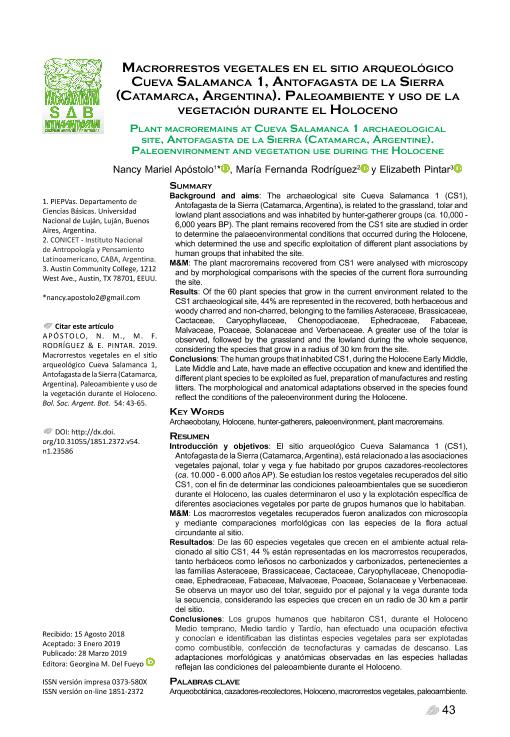Artículo
Introducción y objetivos: El sitio arqueológico Cueva Salamanca 1 (CS1), Antofagasta de la Sierra (Catamarca, Argentina), está relacionado a las asociaciones vegetales pajonal, tolar y vega y fue habitado por grupos cazadores-recolectores (ca. 10.000 - 6.000 años AP). Se estudian los restos vegetales recuperados del sitio CS1, con el fin de determinar las condiciones paleoambientales que se sucedieron durante el Holoceno, las cuales determinaron el uso y la explotación específica de diferentes asociaciones vegetales por parte de grupos humanos que lo habitaban. M&M: Los macrorrestos vegetales recuperados fueron analizados con microscopía y mediante comparaciones morfológicas con las especies de la flora actual circundante al sitio. Resultados: De las 60 especies vegetales que crecen en el ambiente actual relacionado al sitio CS1, 44 % están representadas en los macrorrestos recuperados, tanto herbáceos como leñosos no carbonizados y carbonizados, pertenecientes a las familias Asteraceae, Brassicaceae, Cactaceae, Caryophyllaceae, Chenopodiaceae, Ephedraceae, Fabaceae, Malvaceae, Poaceae, Solanaceae y Verbenaceae. Se observa un mayor uso del tolar, seguido por el pajonal y la vega durante toda la secuencia, considerando las especies que crecen en un radio de 30 km a partir del sitio. Conclusiones: Los grupos humanos que habitaron CS1, durante el Holoceno Medio temprano, Medio tardío y Tardío, han efectuado una ocupación efectiva y conocían e identificaban las distintas especies vegetales para ser explotadas como combustible, confección de tecnofacturas y camadas de descanso. Las adaptaciones morfológicas y anatómicas observadas en las especies halladas reflejan las condiciones del paleoambiente durante el Holoceno Background and aims: The archaeological site Cueva Salamanca 1 (CS1), Antofagasta de la Sierra (Catamarca, Argentina), is related to the grassland, tolar and lowland plant associations and was inhabited by hunter-gatherer groups (ca. 10,000 - 6,000 years BP). The plant remains recovered from the CS1 site are studied in order to determine the palaeoenvironmental conditions that occurred during the Holocene, which determined the use and specific exploitation of different plant associations by human groups that inhabited the site. M&M: The plant macroremains recovered from CS1 were analysed with microscopy and by morphological comparisons with the species of the current flora surrounding the site. Results: Of the 60 plant species that grow in the current environment related to the CS1 archaeological site, 44% are represented in the recovered, both herbaceous and woody charred and non-charred, belonging to the families Asteraceae, Brassicaceae, Cactaceae, Caryophyllaceae, Chenopodiaceae, Ephedraceae, Fabaceae, Malvaceae, Poaceae, Solanaceae and Verbenaceae. A greater use of the tolar is observed, followed by the grassland and the lowland during the whole sequence, considering the species that grow in a radius of 30 km from the site. Conclusions: The human groups that inhabited CS1, during the Holocene Early Middle, Late Middle and Late, have made an effective occupation and knew and identified the different plant species to be exploited as fuel, preparation of manufactures and resting litters. The morphological and anatomical adaptations observed in the species found reflect the conditions of the paleoenvironment during the Holocene
Macrorrestos vegetales en el sitio arqueológico Cueva Salamanca 1, Antofagasta de la Sierra (Catamarca, Argentina). Paleoambiente y uso de la vegetación durante el Holoceno
Título:
Plant macroremains at Cueva Salamanca 1 archaeological site, Antofagasta de la Sierra (Catamarca, Argentine). Paleoenvironment and vegetation use during the Holocene
Fecha de publicación:
21/03/2019
Editorial:
Sociedad Argentina de Botánica
Revista:
Boletín de la Sociedad Argentina de Botánica
ISSN:
0373-580X
e-ISSN:
1851-2372
Idioma:
Español
Tipo de recurso:
Artículo publicado
Clasificación temática:
Resumen
Archivos asociados
Licencia
Identificadores
Colecciones
Articulos(SEDE CENTRAL)
Articulos de SEDE CENTRAL
Articulos de SEDE CENTRAL
Citación
Apóstolo, Nancy Mariel; Rodríguez, María Fernanda; Pintar, Elizabeth Lucia; Macrorrestos vegetales en el sitio arqueológico Cueva Salamanca 1, Antofagasta de la Sierra (Catamarca, Argentina). Paleoambiente y uso de la vegetación durante el Holoceno; Sociedad Argentina de Botánica; Boletín de la Sociedad Argentina de Botánica; 54; 1; 21-3-2019; 43-65
Compartir
Altmétricas




